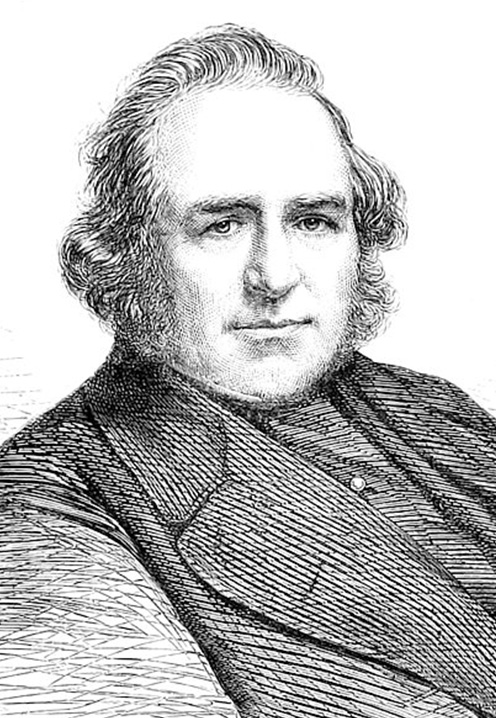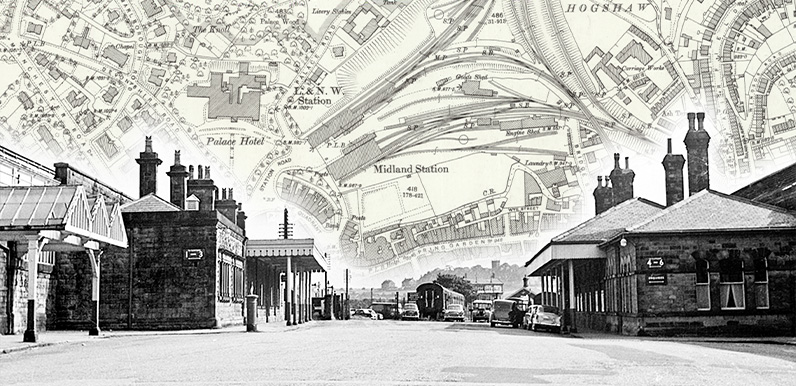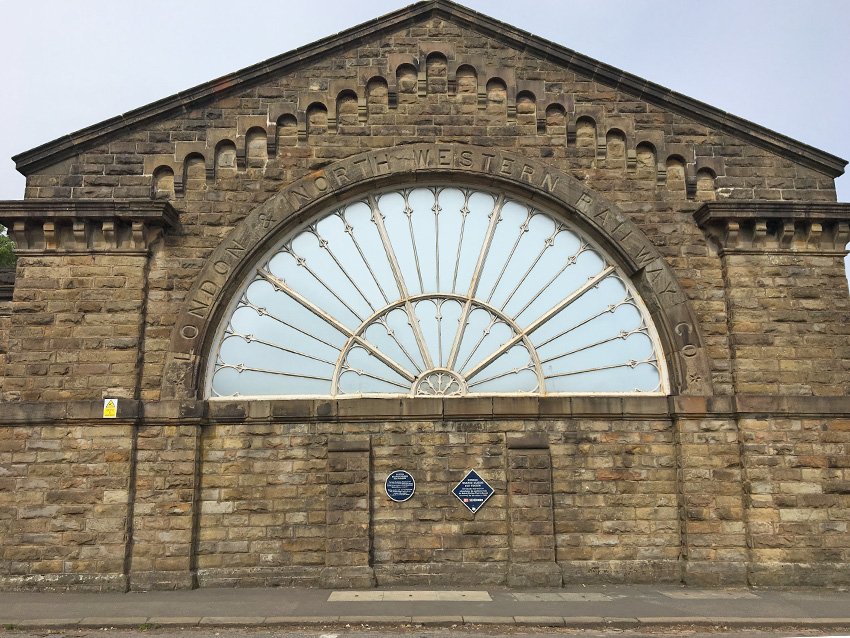Above: Buxton’s twin stations pictured in the mid ’60s, shortly before the one on the right was demolished.
The Palace Hotel would have been behind and to the left of the photographer (see map).
Today, this view looks down Station Road towards Bridge Street.
Above: Both stations had matching semi-circular windows. But only the LNWR’s has survived, as the lettering above proudly testifies (click to enlarge).
Buxton’s natural springs have been attracting visitors for centuries. Mary Queen of Scots was probably the most famous, first arriving in 1576. And like Mary, most were hoping that a spa-water treatment would do wonders for their health.
A trip to enjoy the scenic beauty of the Goyt Valley would have been popular. But only for those with enough money and spare time to enjoy such leisurely pursuits. I doubt whether many workers and their families would have ventured that far. And I’m sure they wouldn’t have been welcomed by local gamekeepers and estate workers.
But by the last quarter of the 19th century, the picture had started to change. The railways arrived at Buxton in 1863. And workers were demanding – and getting – holidays to escape their daily grind. It meant that increasing numbers of middle-class, and then working-class families, could explore the picturesque delights of the valley.
The popular Victorian writer, Strephon, waxed lyrical in newspaper articles and books about the natural beauty of the valley. Postcards of the valley were hugely popular, spreading the word even further. Both Goyt’s Bridge farmhouses opened tearooms to cater for the visitors. And they were arriving at both railway stations from far and wide.
I came across a book the other day on the history of Buxton’s railway lines (Ambergate to Buxton by Middleton Press*). It includes this photo of Buxton’s railway stations taken in the 1950s. Drag the slider to see the view today and there’s an obvious difference. One of the buildings has vanished. It made me curious to discover more.
It seems that two major railway lines were competing to link Derby with Manchester, via Buxton, in the 1860s; the Midland Railway (MR) and the London and North Western Railway (LNWR). Buxton’s councillors were concerned that two stations could spoil the town’s character, and engaged the famous architect, Joseph Paxton, to come up with an acceptable solution.

Above: Sir Joseph Paxton (1803-65) rose from a humble gardener to a Member of Parliament, thanks to the patronage of the Duke of Devonshire.
His other great claim to fame is the ‘Cavendish banana’, first cultivated by Paxton at Chatsworth, and now the most popular banana in the world!
Paxton’s twin stations
Paxton had made a name for himself designing the Duke of Devonshire’s arboretum at Chatsworth. And had gone on to earn fame and fortune creating the Crystal Palace at the Great Exhibition in 1851.
Paxton insisted that the MR and LNWR stations be built next to each other, and in a similar, complimentary style. Both were opened on the same day, on 1st June 1863. (Paxton managed to attend both celebratory lunches!)
Up until the end of the 19th century, the two lines were great rivals, competing for the lucrative London to Manchester passenger traffic. But in 1908 the two companies decided this was too expensive and signed an agreement to co-operate and eliminate waste.
In January 1948, both lines became part of British Railways. By the 1960s the services had reduced to only four in each direction. The 1963 Beeching Report recommended the closure of the MR line. And the station was demolished some time after 1967.
The LNWR station survived, but lost its roof. A new ring road was built through the site of the old MR station, leaving just a small section of wall and some large iron gate brackets.
Over the following years, there were calls for Buxton’s remaining line to suffer the same fate. But thankfully, it has survived.
Old photos reproduced from ‘Ambergate to Buxton’, published by Middleton Press (01730 813169): www.middletonpress.co.uk. Forthcoming titles include Buxton to Stockport (published 27th July 2019), Uttoxeter to Buxton (due 21st September 2019), Cromford & High Peak (Rail and Trail) (due 19th October 2019). All are £18.95 post-free from the publisher.



I’m not 100% sure but I don’t think Dr Richard Beeching actually closed London Midlands’s Buxton to Millers Dale line. It was a knock-on effect of losing its services due to Beeching.
The ‘Millers Dale Line’ was closed to passenger services on the 6th March 1967 and the track was ripped up during the summer of 1968. I believe that the closure was the work of the late Dame Barbara Castle, who was continuing the policy of railway closures started by Ernest Marples and his son-in-law, Dr. Richard Beeching, during the Macmillan/Douglas-Home administration.
The Beeching Report actually advocated retention of the former Midland line through the Peak District but suggested closure of intermediate stations. It was Barbara Castle of the Labour Govt. who permitted the line’s closure as no enduring need for its retention had been demonstrated. It was only kept alive from 1966-68 by the on-going engineering work to electrify the West Coast Mainline. Once the electrification was completed, the Peak Line (Midland Railway) was shut.
Good to see the page re the railway stations. Whilst the Midland station closed in the 60s, and was demolished, this was not to allow the construction of the new road. That came much much later – in 1987. The shopping centre came before the ring road. See this page.
Rather strange that no one has mentioned the third railway station in Buxton. It was just past Lightwood Road and had a single platform. You could get off there, but not on. I suppose it was about opposite where Hogshaw tip used to be. It was used to mainly serve the golf course and it was known as Fairfield Halt. I’ve got a photo of it.
Higher Buxton Station, Silverlands, a station to Ashbourne, then a goods/coal yard.